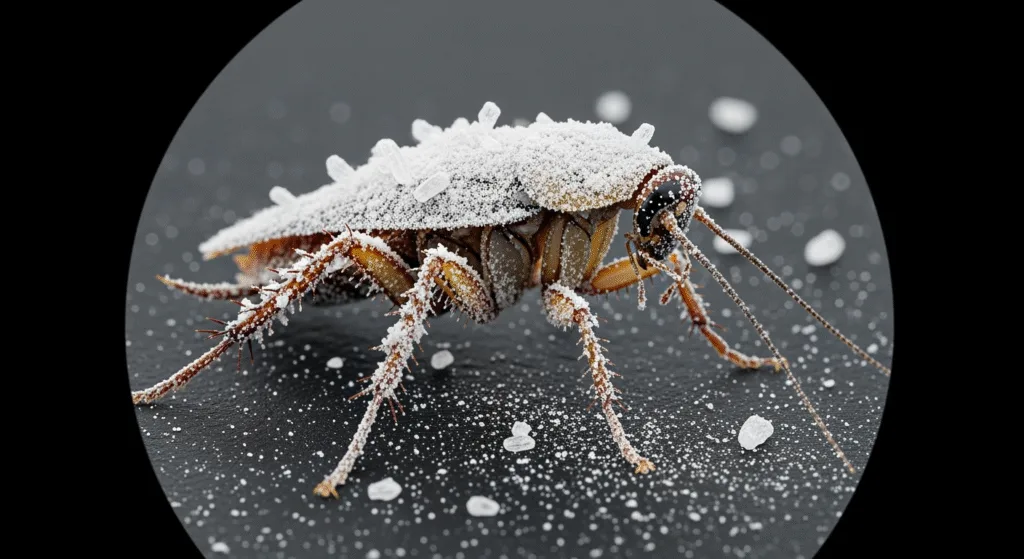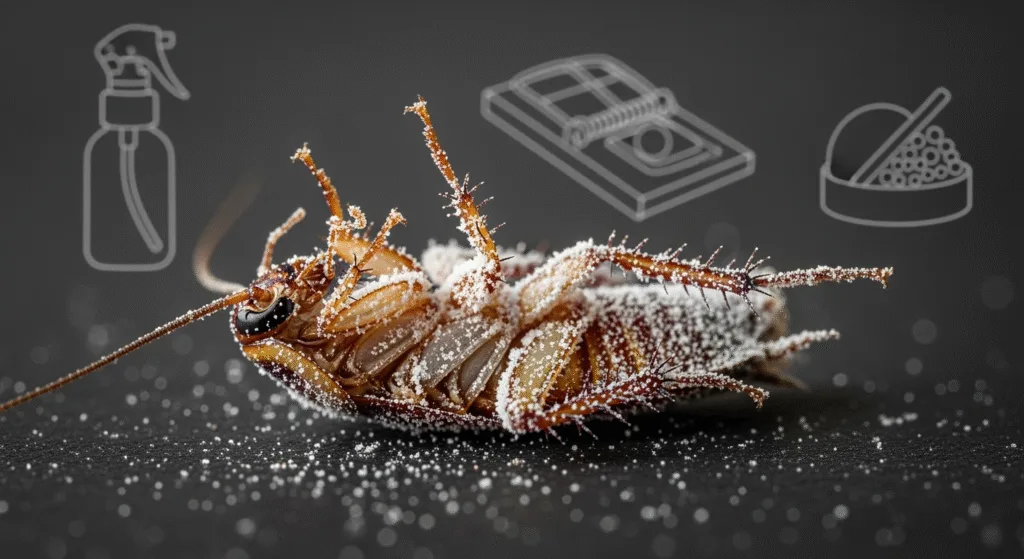Diatomaceous Earth and Roaches
Few household pests inspire the same level of frustration as the cockroach. These resilient insects thrive in conditions where many other species struggle. They infest kitchens, bathrooms, basements, and can even survive off small food particles left behind in corners. To address this problem, homeowners often look for chemical sprays or professional extermination services. However, another natural product, diatomaceous earth cockroaches treatment, has become increasingly popular.
Diatomaceous earth, sometimes called DE, is a fine powder made from fossilized remains of diatoms, a type of algae. People often turn to DE because it is natural, safe when used properly, and can be effective in combating insects. But understanding how it works with roaches requires a little more explanation.
How Diatomaceous Earth Works Against Roaches

Diatomaceous earth cockroaches treatment works on a physical level rather than a chemical one. The powder is made up of microscopic, sharp edges. To us, these particles feel soft, like flour. But to small insects with delicate exoskeletons, the particles act like tiny blades. When a cockroach crawls across surfaces dusted with DE, the powder clings to it, cutting the exoskeleton and absorbing oils and fats. This process dehydrates the insect, eventually killing it.
Unlike chemical sprays, DE does not rely on poison. This means that roaches cannot develop resistance. However, its effectiveness does depend on how and where you apply it. When used carelessly, it may not reach the hiding places of roaches.
Advantages of DE Over Chemical Sprays
- Non-chemical and natural option
- Safe for children and pets when used according to instructions
- Affordable and widely available
- Roaches cannot develop resistance
Limitations to Keep in Mind
- Must stay dry to remain effective
- Takes longer to work compared to poisons
- Requires proper application in hidden areas
Application Techniques for Maximum Effectiveness
Knowing how to apply diatomaceous earth cockroaches treatments is crucial. Many people simply sprinkle it in obvious spots, but roaches tend to hide in cracks, crevices, and under appliances. Effective use requires precision and consistency.
Where to Apply
- Behind and under refrigerators, stoves, and dishwashers
- Along baseboards and under sinks
- In cabinets, especially near food storage areas (but not directly on food)
- Cracks in walls or near plumbing fixtures
How Much to Use
Less is more. A thin layer is all you need. Thick piles of DE allow roaches to avoid contact by simply crawling around them. Spread the powder so lightly that it is almost invisible.
Maintenance and Reapplication
You will need to reapply DE in certain situations. For example, if the powder gets wet—through spills, leaks, or humidity—it loses its sharp, dehydrating properties. Reapply after cleaning or after any exposure to water. Consistency is key to outlasting a cockroach infestation.
Safety Considerations
While diatomaceous earth cockroaches treatments are considered safe compared to chemical pesticides, there are still some safety measures to remember. Food-grade DE is the version recommended for pest control. Pool-grade DE, which is heat-treated and used in filtration systems, should not be used, as it can be harmful when inhaled.
Safe Handling Tips
- Always use food-grade DE for pest control.
- Avoid breathing in large amounts of powder. Wear a mask during application if possible.
- Store DE in a dry container, away from children’s reach.
- Do not apply directly on food or surfaces used for direct food preparation.
For Homes with Children and Pets
Parents and pet owners should take extra care when applying DE. Applied properly, it poses little risk to children or animals. However, it’s best to avoid leaving visible piles where children or animals might directly interact with it. If your pet licks a dusting off the floor, it usually isn’t dangerous, but intentional, repeated consumption should be avoided.
Comparing Effectiveness: Diatomaceous Earth vs. Other Methods

It helps to compare diatomaceous earth cockroaches treatments with other common pest-control methods. Each has benefits and drawbacks. Consider this comparison table:
| Method | Pros | Cons |
|---|---|---|
| Diatomaceous Earth | Non-toxic, natural, affordable, long-lasting | Slow to work, requires proper application, must be dry |
| Chemical Sprays | Fast-acting, easy application | Toxic fumes, resistance possible, unsafe around pets/children |
| Bait Traps | Targets hiding roaches, reduces colonies | Works slowly, needs refilling, may not reach every insect |
| Professional Exterminators | Thorough, expert guidance, advanced chemicals | Expensive, may rely heavily on chemicals |
As the table shows, DE shines as a safe, affordable long-term solution. Yet in severe infestations, combining methods may lead to the best outcomes.
Additional Tips for Roach Control
Diatomaceous earth cockroaches treatments work best when paired with other preventive actions. Roaches seek food, water, and shelter. Limiting these encourages them to encounter the DE more quickly and consistently.
Eliminate Food Sources
- Store food in sealed containers.
- Clean crumbs, grease, and spills daily.
- Empty trash bins regularly.
Reduce Water Availability
- Fix leaks immediately.
- Do not leave pet water bowls overnight if possible.
- Wipe sinks dry before going to sleep.
Minimize Hiding Spots
- Seal cracks in walls, floors, and cabinets.
- Declutter storage areas.
- Organize boxes and bags off the floor where possible.
Combine with Monitoring
Sticky traps can track roach activity. When placed along walls and near suspected hiding places, they show how infestation levels change over time. Paired with DE, they let you know whether your application is working or needs adjustment.
Long-Term Strategy for Keeping Homes Roach-Free
Tackling roaches is not just about quick fixes. To enjoy lasting relief, you should build a strategy that incorporates diatomaceous earth cockroaches prevention routines with vigilance and cleanliness. Roaches survive in the toughest environments because they adapt easily. But you can stay ahead if you stick to consistent prevention.
Routine Inspections
Check under sinks, behind appliances, and inside cabinets every few weeks. Look for droppings, shed skins, egg casings, or grease marks. Spotting trouble early makes it easier to manage with DE instead of calling in a professional.
Layered Defense
Combine your approaches. For example, dust DE in hiding places but also use baits where roaches are active. Seal cracks and practice good sanitation. This multi-pronged approach strengthens protection long-term.
Seasonal Reapplication
Roaches thrive in warmer months. Before spring and summer, refresh DE applications around the home. By preemptively creating barriers, you reduce the chance of roaches gaining a foothold.
When to Call Professionals
Despite your best efforts, roaches sometimes persist. If after consistent DE use and cleanliness routines you still see heavy activity, contact a pest control service. Professionals may use targeted measures alongside your established DE treatment for a stronger impact.
Conclusion
Diatomaceous earth cockroaches solutions offer an effective, natural, and safe path for controlling infestations in the home. While they require patience and careful application, the reward is a cleaner, healthier, and pest-free environment. When paired with sanitation, crack sealing, and vigilance, DE prevents infestations from getting out of control. It may not be the fastest fix, but it is one of the safest and most affordable. For families, pet owners, and anyone looking to avoid heavy reliance on chemical pesticides, diatomaceous earth stands as a proven solution worth trying.
Keep in mind that roach control is never just a one-time action. It’s about building habits and keeping consistent barriers. With DE as part of your strategy, you have a sustainable, long-term defense against one of the most unwelcome pests on earth.



